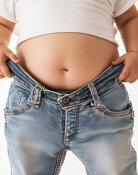Chilling Toothaches

Mr. Lim (26, office worker) suffers a toothache in his bottom teeth whenever he drinks cold water. The toothache is not that bad in his upper teeth, but the ache in his bottom teeth is unbearable. Lim, who is in his 20s, did not worry much about that until now, since he placed too much confidence in his youth. However, he eventually went to see a dentist because the toothache was getting worse.
The toothache with a chilling feeling is common among adults, with one out of seven suffering from it. The toothache accompanies a chilling feeling triggered by a stimulus even when there is no decayed tooth or paradentitis. Teeth with this kind of ache are called hypersensitive teeth. The chilling ache is a warning sign that the teeth have a chance of being decayed or having paradentitis.
The Chilling Ache is Caused by a Lack of a Protective Layer-
Healthy teeth (dentine) are protected by not only by gums, but also by enamel which is solid. The toothache with a chilling feeling occurs when the dentine is exposed due to damaged gums and enamel. External stimuli such as cold water, hot foods, and sour or sweet foods are transmitted through thin tubes (dentine fine tubes) to tooth nerves, causing pain. A dentine fine tube is filled with tissue fluid which moves like water and transfers external stimuli to nerves. Canine teeth, with sensitive nerves, and grinding teeth are especially prone to the ache.
The chilling ache itself is not dangerous. Whats problematic is that people with the ache tend to become unwilling to their brush teeth because of the toothache, triggering paradentitis or tooth decay.
Those who enjoy tough squid and odol bones, a pork dish, have a high chance of coming down with the chilling ache-
Brushing teeth horizontally wears away the part where teeth and gum meet and causes or worsens the chilling ache. In addition, acid foods melt enamel, causing the ache.
Those who have bleeding gums and have gum diseases such as gums moved downward are likely to have the ache. Plaque, food residue and tartar on the teeth produce toxins, aggravating the chilling ache.
People who enjoy tough squid or Odol bone may have cracks in their teeth and have the ache. In particular, the grinding teeth in the upper and bottom part of the mouth are vulnerable to the ache. Some may feel like they are being electrocuted when chewing. Cracks that are not that serious heal themselves, but teeth with serious cracks should receive nerve treatments.
Avoid Whitening Toothpastes-
Education about the correct usage of toothpaste and brushing helps a lot in treating the ache. Some think brushing teeth worsens the ache. However, brushing removes plaque, food residue, and alleviates the ache.
Meanwhile, the chilling ache caused by gum diseases should be treated by removing tartar through scaling and appropriated measures. Cracks in the teeth need to be filled with resin.
People with the ache need to use toothpaste that doesnt wear on teeth. Among recommended toothpastes for people with the ache are Sensodine and Sirinmed. Sensodine fills the exposed dentine fine tubes and blocks external stimuli. Sirinmed forms a protective layer over the teeth.
Toothpastes containing fluorine and xilytole that prevent tooth decay are recommended. It is a good idea to encourage children with the ache to use tooth paste with their favorite colors or tastes. Recently, many people are using toothpastes that make teeth brighter or whitening toothpastes. However, those products should be avoided by people with the ache since those tooth pastes wear away teeth.
Insadol and Igatan are effective as supplementary medicines only on teeth that receive dental treatment.
(Information provided by Lee Seong-gu, publicity director of the Seoul Dental Association, and Lee Jeong-hyun, director of the oral internal department at Daejeon Sun Dental Hospital.)
Jin-Han Lee likeday@donga.com






